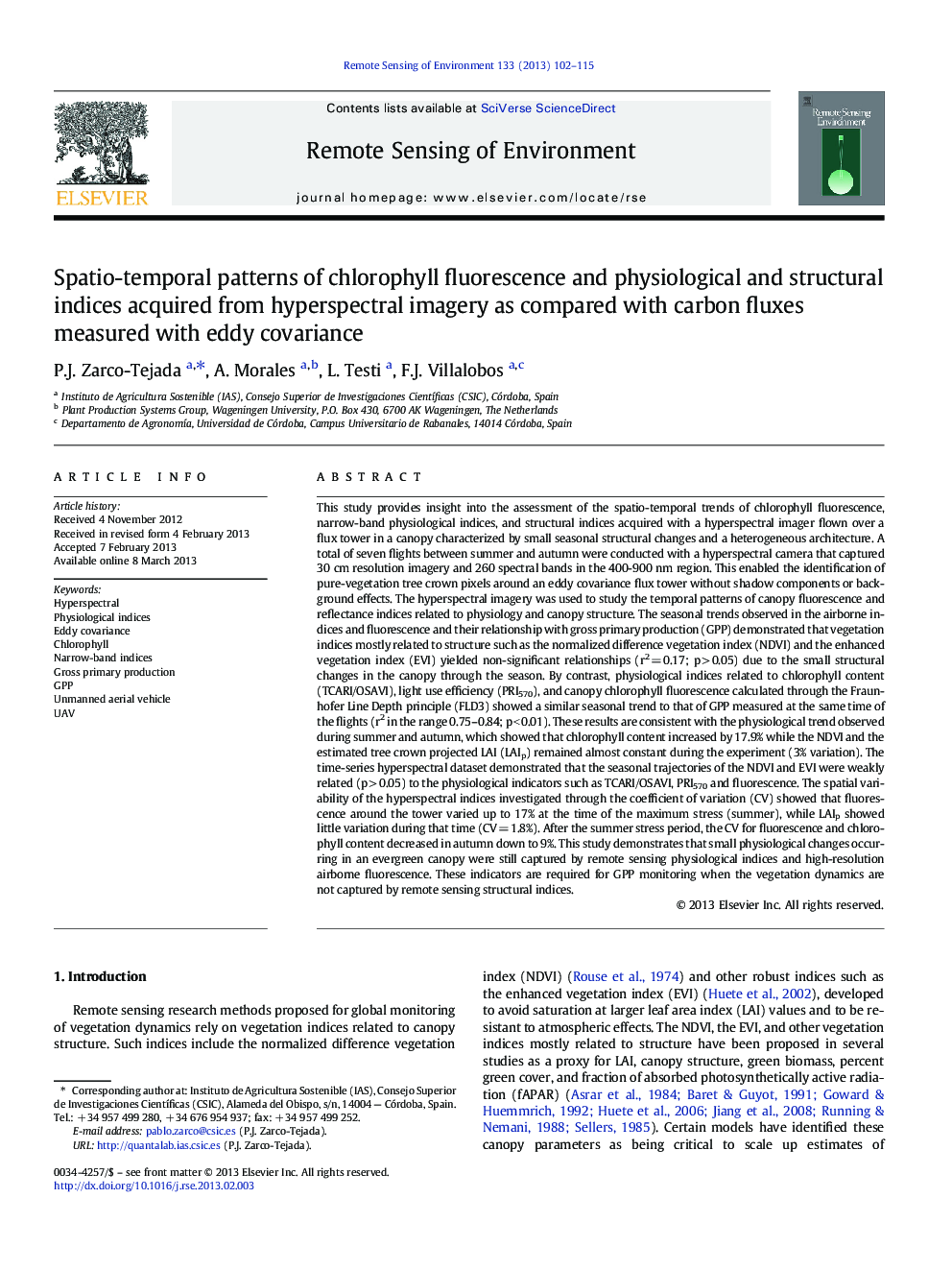| کد مقاله | کد نشریه | سال انتشار | مقاله انگلیسی | نسخه تمام متن |
|---|---|---|---|---|
| 4458939 | 1621267 | 2013 | 14 صفحه PDF | دانلود رایگان |

This study provides insight into the assessment of the spatio-temporal trends of chlorophyll fluorescence, narrow-band physiological indices, and structural indices acquired with a hyperspectral imager flown over a flux tower in a canopy characterized by small seasonal structural changes and a heterogeneous architecture. A total of seven flights between summer and autumn were conducted with a hyperspectral camera that captured 30 cm resolution imagery and 260 spectral bands in the 400-900 nm region. This enabled the identification of pure-vegetation tree crown pixels around an eddy covariance flux tower without shadow components or background effects. The hyperspectral imagery was used to study the temporal patterns of canopy fluorescence and reflectance indices related to physiology and canopy structure. The seasonal trends observed in the airborne indices and fluorescence and their relationship with gross primary production (GPP) demonstrated that vegetation indices mostly related to structure such as the normalized difference vegetation index (NDVI) and the enhanced vegetation index (EVI) yielded non-significant relationships (r2 = 0.17; p > 0.05) due to the small structural changes in the canopy through the season. By contrast, physiological indices related to chlorophyll content (TCARI/OSAVI), light use efficiency (PRI570), and canopy chlorophyll fluorescence calculated through the Fraunhofer Line Depth principle (FLD3) showed a similar seasonal trend to that of GPP measured at the same time of the flights (r2 in the range 0.75–0.84; p < 0.01). These results are consistent with the physiological trend observed during summer and autumn, which showed that chlorophyll content increased by 17.9% while the NDVI and the estimated tree crown projected LAI (LAIp) remained almost constant during the experiment (3% variation). The time-series hyperspectral dataset demonstrated that the seasonal trajectories of the NDVI and EVI were weakly related (p > 0.05) to the physiological indicators such as TCARI/OSAVI, PRI570 and fluorescence. The spatial variability of the hyperspectral indices investigated through the coefficient of variation (CV) showed that fluorescence around the tower varied up to 17% at the time of the maximum stress (summer), while LAIp showed little variation during that time (CV = 1.8%). After the summer stress period, the CV for fluorescence and chlorophyll content decreased in autumn down to 9%. This study demonstrates that small physiological changes occurring in an evergreen canopy were still captured by remote sensing physiological indices and high-resolution airborne fluorescence. These indicators are required for GPP monitoring when the vegetation dynamics are not captured by remote sensing structural indices.
► 30 cm hyperspectral imagery was acquired on a canopy with small seasonal structural changes.
► Physiological changes in an evergreen canopy were captured by fluorescence.
► NDVI and EVI were not significant (p > 0.05) due to the small canopy structural changes.
► TCARI/OSAVI, PRI and fluorescence showed similar seasonal trend than GPP (p < 0.01).
► Physiological indices are required for vegetation dynamics when structural indices fail.
Journal: Remote Sensing of Environment - Volume 133, 15 June 2013, Pages 102–115